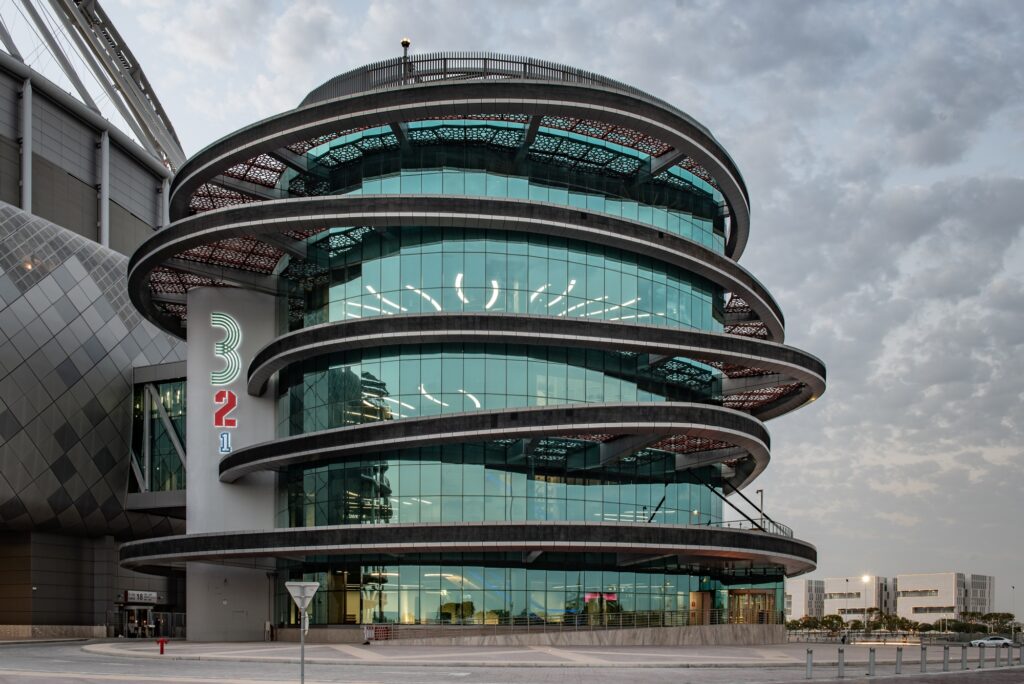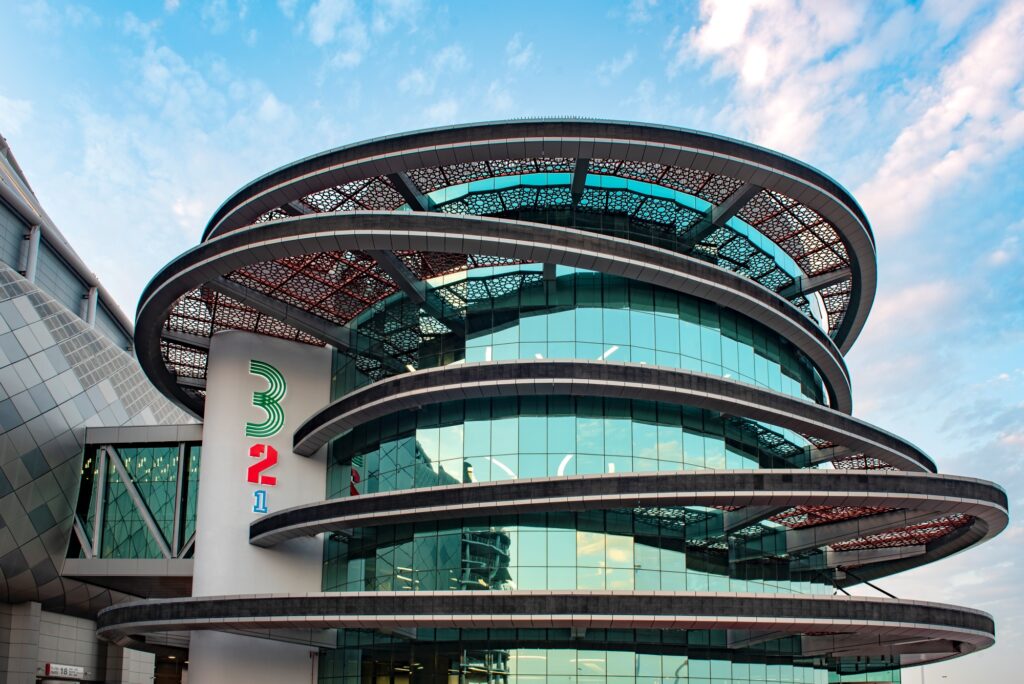Olympic Rings Direct to 3-2-1 Qatar Olympic and Sports Museum
The 3-2-1 Qatar Olympic and Sports Museum at Khalifa International Stadium is said to be one of the world’s largest and most comprehensive sports museums that offers an unforgettable interactive journey through the history and legacy of sports around the globe and the Olympic Games.
Qatar Museums under the patronage of His Highness the Amir, Sheikh Tamim bin Hamad Al Thani, launched the 3-2-1 Qatar Olympic and Sports Museum in March 2022. A member of the Olympic Museums Network (OMN), 3-2-1 is one of the world’s most innovative and technologically advanced museums dedicated to sports. Through its participatory spaces and programming, 3-2-1 aims to inspire and engage its community and encourage the public to take part in sports and physical activity. Designed by Spanish architect Joan Sibina, the museum is approximately 19,000 square metres—making it one of the largest of its kind—and is built onto Khalifa International Stadium, part of Qatar’s Aspire Zone Foundation. The Stadium, originally constructed in 1976, will host the FIFA World Cup Qatar 2022™.
The museum is comprised of two volumes: a curved building that subtly hugs the Dar Al-Handasah-designed stadium, and a cylindrical, ring-wrapped volume that protrudes from the side of the stadium. A stadium design that is very different and contemporary from Qatar’s other museum designs, the glazed tubular structure that forms the façade of the new Museum is encircled by five Olympic-coloured rings that wrap around the museum at different heights and angles – a reflection to the interlocked rings of the Olympic logo. Sibina covered the cylindrical structure in rectangular glass panels that reflect the stadium’s surroundings.
 While being classified as an Olympic structure with the coloured rings visible from far, the architect has given a touch of traditional with the Jali-like screens, used in Islamic cultures to provide privacy, that are placed horizontally between the rings and the glazed facade, providing a decorative element that ties the building to the history of Qatar and its culture.
While being classified as an Olympic structure with the coloured rings visible from far, the architect has given a touch of traditional with the Jali-like screens, used in Islamic cultures to provide privacy, that are placed horizontally between the rings and the glazed facade, providing a decorative element that ties the building to the history of Qatar and its culture.
 The second volume takes a more subtle approach and employs design cues from the 46-year-old Khalifa International Stadium. This volume, adorned in rows of diamond-shaped panelling, follows the curvature of the tallest sides of the stadium and snugly sits between the stadium and the structure wrapped in Olympic rings.
The second volume takes a more subtle approach and employs design cues from the 46-year-old Khalifa International Stadium. This volume, adorned in rows of diamond-shaped panelling, follows the curvature of the tallest sides of the stadium and snugly sits between the stadium and the structure wrapped in Olympic rings.
“The opening of the 3-2-1 Qatar Olympic and Sports Museum alongside the FIFA congress is a symbol of the importance of sports in Qatar National Vision 2030. The museum belongs to the Olympic Museums Network, and is a legacy project of the Doha Asian Games 2006,” said Her Excellency Sheikha Al Mayasa bint Hamad bin Khalifa Al Thani, Chairperson of Qatar Museums. “The 3-2-1 Qatar Olympic and Sports Museum, comes after Qatar’s outstanding performance at the Tokyo Olympics, and just before we host the World Cup in November 2022. Culture and sports are two sides of the same coin, and there is no better time to celebrate our nations investments in both Culture and Sports. Two pillars that also support Qatar’s investments in Education and Health.” Finally, she added, “The opening promises to celebrate the Qatari athletes with the world; a testament of the leadership of His Highness the Emir in focusing on developing people in all fields.”
The Museum’s unique exhibits and remarkable collection present the role of sports as one of the most significant cultural developments, the history and contemporary significance of the Olympic Games, the stories of sporting heroes around the world, and the inspiring story of the development of sports in Qatar, and explore the massive impact of mega events hosted by Qatar in recent decades. The interactive experiences in 3-2-1’s “Activation Zone” will promote sports across Qatar, inspire future talent, and encourage the adoption of healthy and active lifestyles for all. 3-2-1 comprises seven gallery spaces housing objects from around the globe, from the origins of sports to the present day. The galleries–organised under the direction of Kevin Moore, PhD, Deputy Director of Curatorial Affairs–include “World of Emotion,” the first gallery space visitors will encounter, which serves as the Museum’s reception area and lobby and provides an overview of the Museum’s themes and the central role of sports in Qatar.
Another gallery space, “A Global History of Sport” is a journey through the history of sports across the globe from ancient to modern times. The gallery includes nearly 100 objects and reproductions, ranging from the 8th century BCE to the early 20th century, accompanied by graphics, audio-visual and interactive digital elements. The gallery is organised into geographic and thematic sections, focusing on different historical periods in Europe, Asia and Oceania, the Americas, Africa, and the Middle East.
“Olympics” takes visitors from the ancient Olympic Games through to the birth of the modern Olympics and their growth and significance today. The gallery features a display of every torch from the Summer and Winter Olympic Games from 1936 onwards. Within the gallery’s Olympic Theatre is an immersive video that tells the story of the birth of the modern Olympics and introduces the geopolitical, social, and technological factors that enabled individuals, most notably Pierre de Coubertin, to revive the Olympic Games.
 “The Hall of Athletes” is a celebration of sporting heroes from around the world. Here visitors can meet heroes, old and new, and be inspired and amazed by their journeys and achievements. Across three floors, this gallery will profile 90 athletes from across the world and the 20th and 21st centuries, representing a wide range of international sports. Included will be a series of eye-catching displays, each focusing on a different athlete and will include informative text as well as intriguing or awe-inspiring objects (both historic and replicas).
“The Hall of Athletes” is a celebration of sporting heroes from around the world. Here visitors can meet heroes, old and new, and be inspired and amazed by their journeys and achievements. Across three floors, this gallery will profile 90 athletes from across the world and the 20th and 21st centuries, representing a wide range of international sports. Included will be a series of eye-catching displays, each focusing on a different athlete and will include informative text as well as intriguing or awe-inspiring objects (both historic and replicas).
“Qatar – Hosting Nation” explores how the mega sports events hosted by Qatar in recent decades have become a matter of global fascination and national pride . The gallery invites visitors to explore Qatar’s outstanding reputation as a host for international sporting events starting with the Asian Games Doha 2006 and to revisit the most memorable moments of world-class events that the nation has held, including those at Khalifa Stadium since its opening in 1976.
“Qatar Sports” presents the inspiring story of the development of sports in Qatar, from traditional games through to the arrival of international sport and the development of international competitions. The gallery explores how sports has been and continues to be essential to the development of Qatar, looking ahead to the FIFA World Cup Qatar 2022™. The gallery also brings to life Qatar’s long-established sports activities such as falconry, pearl diving and camel racing, exploring how these sports are reflected in Qatar’s oral traditions and illustrating how they are connected to Qatar’s heritage and landscape.
The “Activation Zone” promotes physical activity across Qatar encourages the adoption of healthy and active lifestyles. Visitors can walk through six spaces that evoke the landscape of Qatar. As they discover the park, the market and desert, the beach, city and finally the arena, visitors will participate in a variety of fun challenges.
The design by Sibina comprises two buildings: a main structure that follows the arc of the Stadium, and an attached round access building inspired by the Olympic rings. Khalifa International Stadium is part of Aspire Zone, also known as Doha Sports City, a 250-hectare (2.5 km) sporting complex located in Baaya district of Doha that also includes the Aspire Academy for Qatar’s youth, Hamad Aquatic Centre, Aspire Tower and Doha’s largest park, Aspire Park.
The café and restaurant at 3-2-1 Qatar Olympic and Sports Museum are operated by the JW Marriott with the menu concepts designed by Chef Consultant Tom Aikens, a UK-born Michelin-star chef and avid marathon runner. The 3-2-1 Café, located on the first floor of the Museum, offers visitors tasty, wholesome, freshly made food and drink options as well as takeaway offerings.
The restaurant, Naua, is located on the fourth floor of the Museum. Named after the Arabic word for nucleus of the seed, the restaurant promotes mindful, healthy eating. The menu offers refined dishes made from high-quality, seasonal ingredients. This casual fine-dining restaurant is set to become Doha’s premier destination for diners who seek the ultimate fusion of the healthy and the gourmet.
The main gift shop, located on the Museum’s second floor, offers visitors a wide range of exclusive merchandise inspired by the legacy of sport and the Olympic Games. Visitors can browse and buy a wide range of sportswear and apparel that showcase the positive value of sport and its significance to sports culture within Qatar and beyond. From local football team kits to vintage Olympic poster prints, there is something for all ages to enjoy.
.




